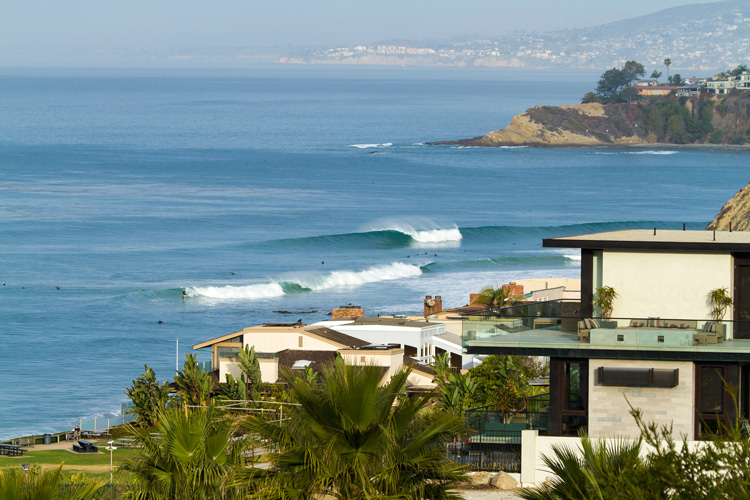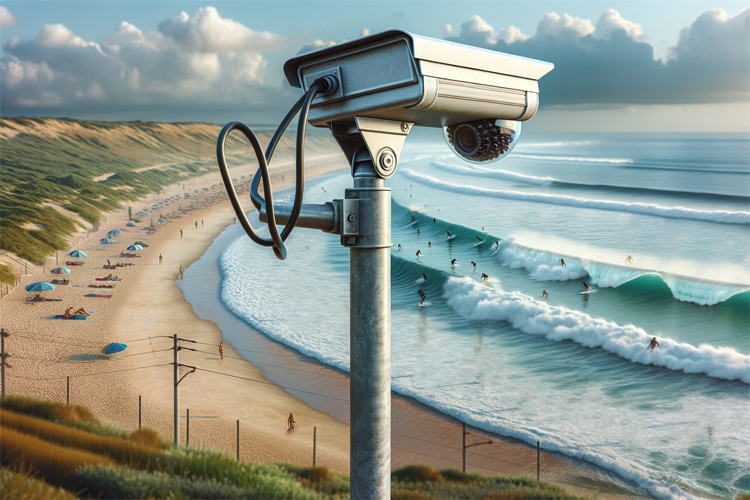Progress and technology are often associated with quality of life and happiness, but they sure come with more or less various downsides.
Throughout the history of surfing, beach surf cameras have always been the subject of love-hate discussions and some serious attacks on private property.
By beach cams, we mean video cameras installed near beaches and surf spots seldom pointed toward the best wave peaks.
Back in the day, in the pre-Information Age (roughly before the 1950s), apart from tides, surfers knew little about what to expect from the ocean.
One of the first attempts to predict the surf to get tactical advantages took place in one of World War II's most critical episodes, the Normandy Invasion's D-Day.
Is there a swell coming? Are there storms in action and sending larger-than-average wave trains? We didn't know much, and in a way, ignorance was bliss.
Let's not forget that the world's first weather satellite - Television Infrared Observation Satellite (TIROS) - was only launched in April 1960.
So, it was hard to tell how storms would produce swells that would then travel thousands of miles before reaching surfable coastlines.
In the 1970s, buoys were deployed in the Atlantic and Pacific Oceans, improving the information available on weather patterns.
Slowly but steadily, more meteo data was being publicly shared worldwide via radio, newspapers, and, later, television.
The first daily surf report services appeared in Australia and the United States. These hotlines provided valuable information on swell size and direction, wind patterns, and tides.
In the 1980s, Sean Collins made these daily advisory services successful businesses with 976-TRAK, Wavefax, Surfalert, and, ultimately, Surfline.
The pioneer surf forecaster brilliantly marketed his brands by giving his customers two options: "Pray for surf... or call Surfline 976-SURF."
When Surfline made it to the World Wide Web (WWW), it was only a matter of tech years before words were replaced by live footage.

The Advent of Live Surf
In 1999, Surfline tested the world's first beach surf cam.
As one might imagine, the quality of the streamed images was less than 4K or even 1080 pixels, as camera resolution, internet availability, and online speed were still in their early days.
And it took quite a long time to have cameras mounted on the world's most famous surf breaks.
In some cases, only occasionally video clips shot at a pre-determined time (7 am, 9 am, 1 pm, 3 pm, etc.) were available, and only a few locations featured live footage, 24/7, 365 days a year.
In the early 2000s, the Surfline surf cam network featured around 75 eyes installed on California, Hawaii, and the US East Coast.
The company also had the first team of surfers hired to check the surf and share the real-time conditions on select surf spots.
In less than a decade, the surf report empire expanded its spy cam coverage and became available on smartphones.
Soon, the world was not enough, and more regional and national beach cam services debuted online, making surf cams a relatively open market more based on location opportunities than tech uniqueness or specific knowledge of the industry.
Beach Surf Cam: The Good and the Bad
Long are the days of catching the bus or train, riding a bike or skateboard, driving a car to the favorite home break, and being surprised by the ocean conditions.
In the pre-internet days, you would either get wet or stay dry, waiting for the tide to turn or wishing you'd chosen a different beach.
And at the end of the year, it was all good. Surfers would have had epic sessions and unexpected disappointments.
Today, nearly all quality waves are under continuous observation, day and night, come rain or shine, by hundreds of thousands of greedy surfer eyes.
Not everything's perfect, and not everything's a disaster. But let's start with the bad news so that we can end on a high.
What are the downsides of having high-quality 4K cameras shooting the surf at our favorite surf breaks?
- Crowd: It's easy to do the math - the better the surf, the larger the pack of wolves. There's no other way around: crowded lineups only got worse with surf cameras mounted by the beach. So, if it's pumping, everyone will want their share of the cake;
- Localism: More surfers coming from the vicinities to ride a particular spot also means more territorial disputes. "Locals only," you may read in the closest parking lot;
- Tension: The sum of a crowded lineup and localism vibes equals tension and, many times, drop-ins and violence in and out of the water. No wonder the creation of surf police patrols to control savagery at the peak;
- Vandalism: When tension escalates, destruction of private property becomes part of the surfing experience. It can start with deflated tires and threatening messages left on the windshield to broken surfboards and stolen or destroyed surf cams;
- Epic Surf Unavailability: Surf cams are a double-edged sword. They will tell you when it's absolutely perfect and pumping, but they will also reduce your chances of having a (nearly) lonely, unforgettable surfing experience;
Having surf cams pointing at the most consistent spots can sometimes be helpful. Here's when and how.
- Dawn Patrol Booster: If the forecast is good and the tide times align, it might be worth trying your luck in the early morning waves. At dawn, you'll find a lineup that is generally less crowded and/or slightly less stressful;
- Increase Scoring Ratio: Knowing when and where it's on and firing could be good news if you aim to score big time. Information is power, so a smart check of your favorite nearby surf breaks could mean more and better surf;
- Saving Time: Imagine you only have a couple of hours to get your weekly surf fix. Checking the cams and knowing where to head for a hit-and-run strike mission might mean getting wet and maintaining our mental health balanced, at least for the short term;
- Increased Options: The ability to run through the live footage of several surf breaks separated by several miles and choose the one that looks better or has a better wave quality/crowd factor ratio is priceless. Moreover, surf cams installed on beaches could help dilute crowds;
- Local Economy Booster: The rise of the beach surf cam network opens new opportunities for small businesses on less-known surf destinations. Cafés, accommodations, restaurants, and surf shops run by surfers and non-surfers may benefit from shifting trends in surf travel;
Words by Luís MP | Founder of SurferToday.com
